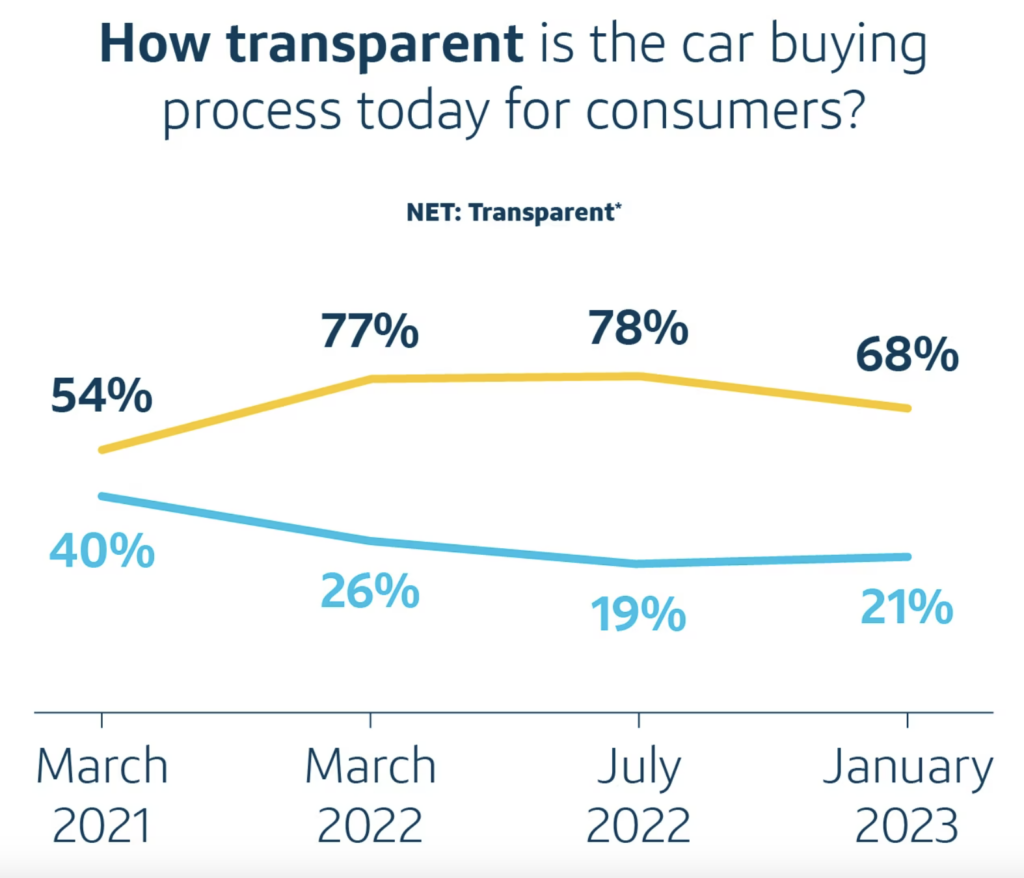
Throughout my journey in automotive retail, I’ve learned that at the heart of a profitable retail operation lies extraordinary customer experience.
I’ve mentioned in the past that I worked in Beverly Hills for many years managing car dealerships (sidenote: it’s not as glamorous as you might think). One thing I know for sure is that if you can make it there, you can make it anywhere. People in BH are demanding, entitled and they expect the moon, but over the years you figure out ways to surprise and delight even the most insufferable people, and it’s actually pretty gratifying to see smiles on their faces.
I believe every person who works in retail should possess a strong commitment to surprise and delight the customer. This rarely happens without strong leadership with a vision and purpose to keep customers coming back.
Here’s a three-sentence paragraph that embodies the importance of customer experience
A friend of mine just shared her car-buying story with me. She visited two dealerships: one where she bought the car, and one where she said she would never buy a car. The difference was customer experience.
Where choices are abundant, retailers must prioritize customer experience to stand out. Effective strategies are fantastic but the only way for those strategies to increase customer loyalty and higher sales is to actually implement them.
Here are 10 proven strategies to help you create your own vision to elevate customer experience.
(They slant towards retail automotive but they are applicable in nearly every other industry or business).
Get my latest business tips, exclusive content, and a bit of fun straight to your inbox with the Kruse Control Newsletter. Boost your profits with our proven advice. Sign up now – it’s free!
1. Treat Customers like Guests in Your Home
Strategy: Every interaction should be warm and welcoming. Think of your customers as guests in your home and offer them unmatched hospitality.
Greet each customer personally, whether digitally or in-person.
Ensure a comfortable and respectful experience through deeds, not just words, much like welcoming a guest at home.
2. Transparency
Transparency builds trust and reduces post-sale dissatisfaction. Be upfront about pricing, including all fees and charges, including financing where applicable, on your website and all sales interactions.
FACT: Dealers (68%) are approximately three times more likely than car buyers (21%) to say that the car buying process is very or completely transparent. [2023 Capital One Car Buying Outlook Study]

Clearly there’s a ‘perception disconnect’ between dealers and their customers.
Some retailers have adopted a no-haggle pricing policy, or a one-price approach which has reduced customer anxiety about negotiating. In stores that have embraced transparency, the repeat customer rate has increased by as much as 30%.
With basically every dealer in the Capital One study agreeing that repeat customers are important (99%), it is crucial car buyers have a positive experience and build trust with dealerships. A majority of car buyers say they are looking to build a long-lasting relationship with a dealer they can trust (58%) and over three-quarters say that they will want to use the same car dealership for future purchases if they have a positive experience (76%).
3. Invest in Your People
Strategy: Your team is your biggest asset. Invest in their training and development, and they will deliver exceptional service.
Train employees in customer service excellence. Offer incentives for high customer satisfaction scores.
Real-Life Example: Mercedes-Benz USA implemented a training program focused on enhancing the customer experience, specifically designed for dealership staff. The primary goal of this program was to equip dealership personnel with skills and strategies to improve customer interactions and satisfaction. As a result of this initiative, dealerships with staff who received higher levels of training in customer experience reported a 15% increase in customer loyalty. This surge in customer loyalty is significant because loyal customers are more likely to return for future purchases and services, thereby boosting the dealerships’ future sales. This case illustrates the direct impact of employee training on customer loyalty and the subsequent positive effect on sales.
4. Long-term Relationships Over Short-term Gains
Strategy: Build lasting relationships with your customers rather than focusing solely on immediate sales ensures a great customer experience and high customer retention.
***I can rattle off over a dozen recent examples right now that I’ve witnessed of the polar opposite of this, but I won’t. You probably can too. Onward.
Real-Life Example: Carl Sewell’s $517,000 customer concept based on the principle that the value of a customer is not just the profit from a single sale, but the total profit from all the purchases that the customer will make over a lifetime.
Mr. Sewell’s 1990 calculation goes like this: If cars are $35K apiece, 12 (bought over a lifetime) would cost $420,000. when you add service for those vehicles, that’s $517,000.
Today’s average new car price is right around $49,000, so 12 would cost $588,000. Add service on top of that and each customer you meet is a $700,000 customer! Is it worth it to take care of your customers and their problems? You bet.
By treating customers well and ensuring their satisfaction, retailers can reap significantly more profit in the long term from repeat business and referrals, rather than focusing solely on the profit from an initial sale. It’s a powerful example of the long-term value of a loyal customer in the automotive industry.
No matter what business you’re in or what you sell, do your own calculation. It’s quite a powerful tool to use when thinking about how you treat each customer.
5. Attention to Detail
Strategy: It’s the little things that count. Pay attention to every detail in the customer’s journey, from your website, to the showroom environment to the follow-up after a sale.
Real-Life Example: Pay close attention to details like clean bathrooms and comfortable waiting areas. Offer top-notch coffee and have delicious pastries delivered every morning. These small touches significantly enhance customer experience and make it memorable enough for customers to mention it to their friends.
6. Embrace Technology
Strategy: Use digital retailing tools for a seamless car-buying experience. Implement virtual showrooms, online financing tools, and digital paperwork.
Use social media to build rapport with your network.
Utilize an online appointment booking system to improve our service efficiency, positively impacting customer satisfaction.
A recent Cox Automotive study highlighted that retailers who effectively use digital retailing saw a doubling in vehicle-detail-page (VDP) views per website visit, which is a well-established metric that means higher sales. (If you’re not from automotive, each vehicle has its own VDP that acts like a landing page where users can find details about the car, as well as vehicle and financing info, a trade-in estimator and contact form).
7. Listen and Adapt
Strategy: Actively seek customer feedback and be willing to adapt based on their needs and suggestions.
Real-Life Example: A recent client issue showed declining customer satisfaction due to long wait times, poor communication, and indifferent staff. They conducted a customer survey to identify issues and then took several steps to improve:
- They implemented an online booking system to reduce wait times.
- Improved communication with regular service updates.
- Trained staff in customer engagement and empathy.
Following these changes, customer satisfaction significantly improved, leading to increased loyalty, more referrals, and a rise in sales and service appointments.
8. Create a Community, Not Just a Customer Base
Strategy: Engage with your customers beyond the dealership. Host events, support local causes, and create a sense of community.
Real-Life Example: I’m a big fan of inviting new owners to a Saturday afternoon clinic where experts are available to answer questions, along with yummy food to make it memorable. You can regularly host customer appreciation events to help build a strong, loyal community around your store.
Pro-Tip: In a lot of cases, the manufacturer will share the costs!
9. Efficient Service Department
Strategy: Ensure quick, efficient, and high-quality service. Streamline the process from booking to service completion.
Real-Life Example: A client revamped their service department by introducing an online appointment system and a fast-track service for minor repairs. They also added an online payment option, making it easier for the customer to pick up their car. This led to a 40% improvement in service satisfaction ratings.
10. After-Sale Experience
Strategy: Excellent after-sale service is as important as the sale itself. Ensure your customers feel valued after their purchase.
Real-Life Example: At Beverly Hills BMW, we sent every customer who bought a car a gift basket. Everyone loved it and it was part of our comprehensive after-sale program, including a loyalty rewards program, leading to a 35% increase in repeat customers.
Enhancing customer experience isn’t just about selling cars; it’s about creating memorable experiences, building lasting relationships, and continuously adapting so you can surprise and delight your customers.
Sign up for the Kruse Control Newsletter: get my latest business tips, exclusive content, and a bit of fun straight to your inbox. Sign up now…it’s free!
